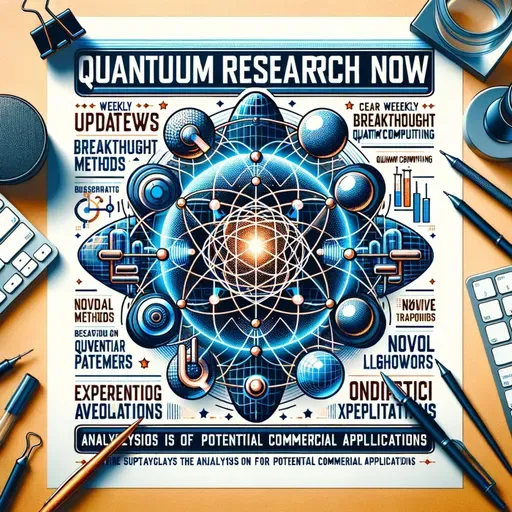
19 November 2025
Quantum Computing Goes Mainstream: AQT's Trapped-Ion Milestone on Amazon Braket
Quantum Research Now
About
This is your Quantum Research Now podcast.
Welcome back to Quantum Research Now. I'm Leo, your Learning Enhanced Operator, and today I'm absolutely buzzing with excitement because something extraordinary happened just hours ago that signals we're entering a new era of quantum computing.
Picture this: it's November 19th, 2025, and while most people are thinking about their Wednesday evening plans, quantum computing companies are reshaping the future. AQT just announced that their trapped-ion quantum computer is now available on Amazon Braket. But here's what makes this genuinely significant—this isn't just another press release. This is the moment when quantum computing stops being a laboratory curiosity and becomes something you can actually rent and use from your cloud provider.
Think of quantum computers like musicians in an orchestra. Traditional computers are a soloist playing one note at a time, perfectly, predictably. Quantum computers? They're the entire orchestra playing multiple melodies simultaneously through something called superposition. When those qubits entangle—which is what we call quantum entanglement—they create relationships where measuring one instantly affects another, even if they're theoretically separated. It's like having orchestra members who can instantly communicate across any distance.
Now, AQT's trapped-ion approach is particularly elegant. Imagine thousands of individual atoms suspended in space by electromagnetic fields, each one a qubit. These ions are incredibly stable compared to other quantum systems. They're like acrobats perfectly balanced on a tightrope, whereas other quantum systems are more like juggling while riding a unicycle—impressive but precarious.
What makes this Amazon Braket integration genuinely transformative is accessibility. Previously, quantum computing was like owning a Formula One racing team—only massive corporations and research institutions could afford it. Now, researchers, startups, and enterprises worldwide can experiment with quantum algorithms without building their own quantum computer. It's democratization happening in real time.
But there's something deeper happening this week. Harvard researchers published findings showing they've created fault-tolerant quantum systems using 448 qubits with error correction capabilities. Meanwhile, IQM Quantum Computers launched Halocene, a 150-qubit system specifically designed for error correction research. And Quantum Computing Inc. unveiled Neurawave, their photonics-based system at SuperCompute25 in St. Louis.
What these announcements share is a fundamental truth: quantum computing is transitioning from theoretical promises to engineering reality. We're moving from "can we?" to "how do we scale it?"
The quantum future isn't some distant horizon anymore. It's happening right now, accessible through your cloud provider, advancing through multiple technological pathways simultaneously. Whether through trapped ions, photonics, or superconducting qubits, we're watching the birth of quantum advantage unfold.
Thanks for joining me on Quantum Research Now. If you have questions or topics you'd like discussed, email leo@inceptionpoint.ai. Subscribe to this podcast and visit quietplease.ai for more information. This has been a Quiet Please Production.
For more http://www.quietplease.ai
Get the best deals https://amzn.to/3ODvOta
This content was created in partnership and with the help of Artificial Intelligence AI
Welcome back to Quantum Research Now. I'm Leo, your Learning Enhanced Operator, and today I'm absolutely buzzing with excitement because something extraordinary happened just hours ago that signals we're entering a new era of quantum computing.
Picture this: it's November 19th, 2025, and while most people are thinking about their Wednesday evening plans, quantum computing companies are reshaping the future. AQT just announced that their trapped-ion quantum computer is now available on Amazon Braket. But here's what makes this genuinely significant—this isn't just another press release. This is the moment when quantum computing stops being a laboratory curiosity and becomes something you can actually rent and use from your cloud provider.
Think of quantum computers like musicians in an orchestra. Traditional computers are a soloist playing one note at a time, perfectly, predictably. Quantum computers? They're the entire orchestra playing multiple melodies simultaneously through something called superposition. When those qubits entangle—which is what we call quantum entanglement—they create relationships where measuring one instantly affects another, even if they're theoretically separated. It's like having orchestra members who can instantly communicate across any distance.
Now, AQT's trapped-ion approach is particularly elegant. Imagine thousands of individual atoms suspended in space by electromagnetic fields, each one a qubit. These ions are incredibly stable compared to other quantum systems. They're like acrobats perfectly balanced on a tightrope, whereas other quantum systems are more like juggling while riding a unicycle—impressive but precarious.
What makes this Amazon Braket integration genuinely transformative is accessibility. Previously, quantum computing was like owning a Formula One racing team—only massive corporations and research institutions could afford it. Now, researchers, startups, and enterprises worldwide can experiment with quantum algorithms without building their own quantum computer. It's democratization happening in real time.
But there's something deeper happening this week. Harvard researchers published findings showing they've created fault-tolerant quantum systems using 448 qubits with error correction capabilities. Meanwhile, IQM Quantum Computers launched Halocene, a 150-qubit system specifically designed for error correction research. And Quantum Computing Inc. unveiled Neurawave, their photonics-based system at SuperCompute25 in St. Louis.
What these announcements share is a fundamental truth: quantum computing is transitioning from theoretical promises to engineering reality. We're moving from "can we?" to "how do we scale it?"
The quantum future isn't some distant horizon anymore. It's happening right now, accessible through your cloud provider, advancing through multiple technological pathways simultaneously. Whether through trapped ions, photonics, or superconducting qubits, we're watching the birth of quantum advantage unfold.
Thanks for joining me on Quantum Research Now. If you have questions or topics you'd like discussed, email leo@inceptionpoint.ai. Subscribe to this podcast and visit quietplease.ai for more information. This has been a Quiet Please Production.
For more http://www.quietplease.ai
Get the best deals https://amzn.to/3ODvOta
This content was created in partnership and with the help of Artificial Intelligence AI